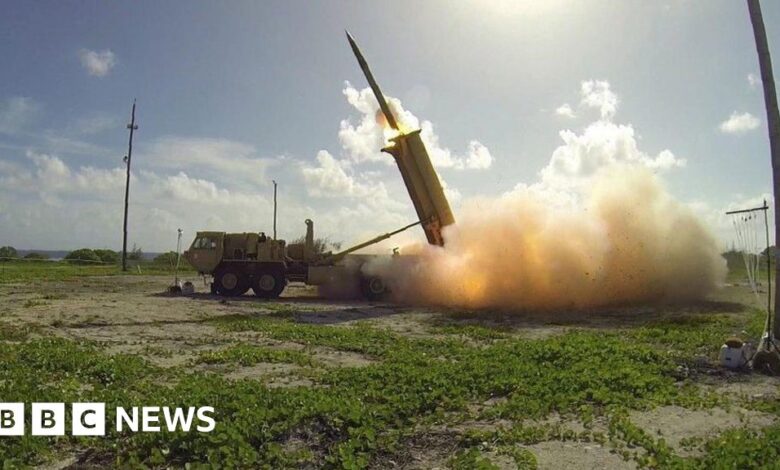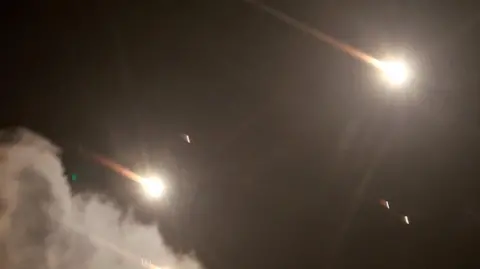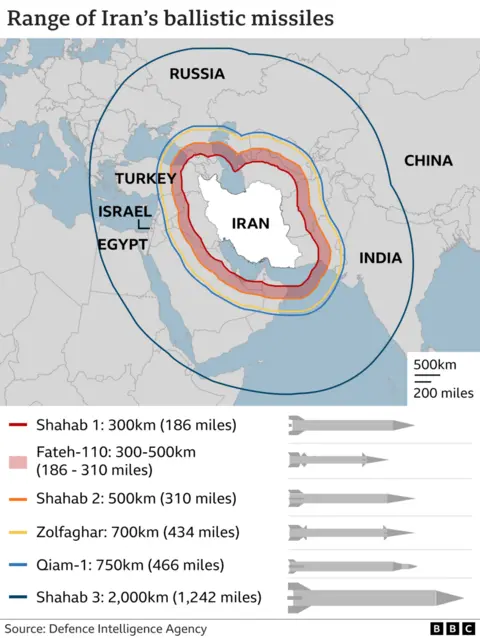Why does the US provide Israel with a powerful anti-missile system?

 AFP via Getty Images
AFP via Getty ImagesThe Pentagon confirmed it is sending a high-altitude anti-missile system operated by the US military to Israel.
The Terminal High Altitude Area Defense (Thaad) system will strengthen Israel’s air defense capabilities following Iran’s missile attack on the country earlier this month, officials said.
President Joe Biden said this was aimed at “protecting Israel”, which is still expected to retaliate for Iran’s attack involving more than 180 ballistic missiles fired at Israel on October 1.
This move has become the focus of attention because it involves the United States sending American troops to Israel.
There are already a small number of US forces in the country – but this new deployment of about 100 troops is significant because it signals deeper US involvement in the expanding regional war.
It is also being scoured for clues about the implications of the effectiveness of Israel’s missile defense system as the crisis intensifies.
According to Defense Minister Yoav Gallant, Israel has yet to take retaliatory action against Iran’s attack, which would have been “lethal, precise and above all surprising”.
Tehran said it opened fire on Israel for assassinating Hassan Nasrallah, the leader of the Iran-backed group Hezbollah, in Beirut.
The Pentagon said an advanced team and components needed for the battery arrived in Israel on Monday — with additional personnel and components to follow in the coming days. A statement said the battery will be operational for the “foreseeable future”.
It remains unclear whether the Thaad deployment is part of a US contingency plan to close identified gaps in Israel’s air defense system or whether it points to growing concerns in Washington. of a stronger Israeli attack on Iran.
President Biden has opposed any attack on Iran’s nuclear facilities, as well as the country’s oil or energy infrastructure, amid growing concerns that it would spark conflict. increase and affect the global economy.
Whatever the basis of this decision, it signals that Israel needs more US defense support in the context of the expanding Middle East war.
 Reuters
ReutersBallistic missiles like the Fattah-1 used by Iran earlier this month are fired into Earth’s atmosphere, where they change trajectory and descend on their targets. One of their military advantages is their superior speed compared to cruise missiles or drones.
According to manufacturer Lockheed Martin, America’s largest weapons manufacturer, the Thaad system is highly effective against ballistic missiles.
Raytheon, another American arms company, makes its own advanced radar systems.
The system counts six truck-mounted launchers, with eight interceptors per launcher. It costs around $1bn (£766m) a battery and requires a team of around 100 people to operate it.
Thaad is sought after by many, including Ukraine, to counter Russian missile attacks.
Saudi Arabia had ordered and reportedly wanted more as part of the US arsenal in exchange for formal recognition of Israel: a so-called “normalization” deal that was largely derailed after October 7 attack by Hamas.

Iran’s October 1 attack on Israel killed a man in Jericho in the occupied West Bank, who was hit by part of a rocket that appeared to have been shot down.
Israel has a much-vaunted air defense system, developed with the United States, that includes the Arrow 2 and Arrow 3 exo-atmospheric missiles.
They fly at supersonic speeds and can shoot down ballistic missiles in space. Israeli system designers said Arrow “performed as expected” with “excellent” results against the Iranian attack.
The United States supported the defense operation, firing interceptor missiles from two naval destroyers in the eastern Mediterranean, along with support from several European and Arab countries.
Washington described Iran’s attack as “failed and ineffective”.
But damage on the ground tells a less clear picture. Satellite images show damage at the Israeli Air Force’s Nevatim base, which houses F-35 fighter jets, including holes in the runway and taxiway.
Decker Eveleth from the Washington-based Center for Naval Analyzes (CNA) said the images showed 32 impact points, including multiple hits to the F-35 hanger area.
“Some F-35s were really lucky,” Mr. Eveleth posted on X.
Israel’s Haaretz newspaper reported that it is still unclear whether the damage was caused directly by missiles or intercepted shrapnel.
There are other direct impacts, including in Tel Aviv. A missile is said to have blown out a 30ft (nine meter) deep crater in a densely populated area near the headquarters of Mossad, Israel’s intelligence agency.

Politically, the Thaad announcement was couched in terms of the Biden administration’s “ironclad” support for Israel’s defense.
According to Israeli data, the US sent more than 50,000 tons of weapons to Israel last year.
But it also highlights some of the policy mistakes Washington made: first, trying to pressure Israel and its opponents not to escalate the war, and instead urging diplomacy.
When that failed, the White House steadfastly supported the decisions of its ally Israel while moving to defend the country diplomatically and militarily.
Iran’s missile attacks followed the assassination of Hamas political leader Ismail Haniyeh (negotiator in the ceasefire and hostage release talks in Gaza), Hassan Nasrallah in Beirut, the Israeli airstrikes on populated areas of Beirut and its ground invasion of Lebanon.
Israel said it had struck against the leadership of Hezbollah and destroyed the group’s massive missile depots as a result of 11 months of cross-border rocket fire into Israel.
They argue that only military pressure and degradation of Hezbollah’s capabilities will ensure the 60,000 Israelis can return to their homes in northern Israel.
The Pentagon describes Thaad’s deployment as part of “broader adjustments the US military has made in recent months” to support Israel and protect US personnel from Iranian attacks and Iran-backed groups.
It said a Thaad was deployed in southern Israel to participate in an exercise in 2019, the last and only time it was known to be there.
It is extremely rare for the US to deploy troops to Israel outside of military exercises, given Israel’s capabilities.
Iran’s Foreign Minister Abbas Araqchi warned on Sunday that the US was putting the lives of its troops “in danger by deploying them to operate US missile systems in Israel”.





